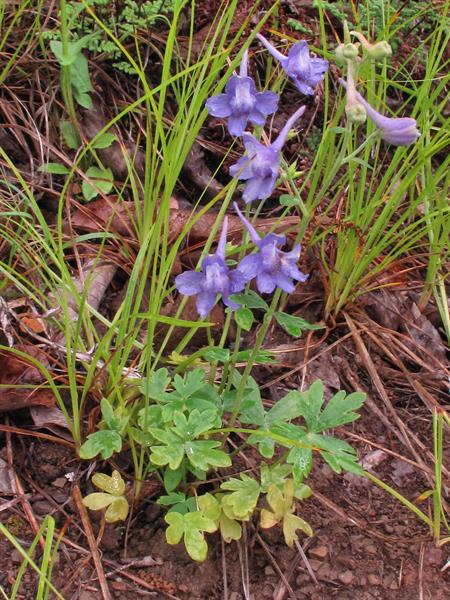
ID notes:The flowers are variable in color, usually a deep bluish violet, but ranging through pink to pure white.
Origin/Endemic status: Native
Synonymy: = Ar, C, F, FNA3, G, GrPl, Il, K1, K3, K4, Pa, RAB, S, S13, Tn, Va, W, WV, Kral (1976)
Heliophily: 3
Hover over a shape, letter, icon, or arrow on the map for definition or see the legend.
 © Keith Bradley | Original Image ⭷
© Keith Bradley | Original Image ⭷ © Richard & Teresa Ware CC-BY-NC, permission granted to NCBG | Original Image ⭷
© Richard & Teresa Ware CC-BY-NC, permission granted to NCBG | Original Image ⭷ © Alan Cressler: Delphinium tricorne, Taylor Ridge Shale Glades, Taylor Ridge, Chattahoochee National Forest, Chattooga County, Georgia 6 by Alan Cressler source | Original Image ⭷
© Alan Cressler: Delphinium tricorne, Taylor Ridge Shale Glades, Taylor Ridge, Chattahoochee National Forest, Chattooga County, Georgia 6 by Alan Cressler source | Original Image ⭷ © Alan Cressler: Delphinium tricorne, basel leaves, Taylor Ridge Shale Glades, Taylor Ridge, Chattahoochee National Forest, Chattooga County, Georgia 1 by Alan Cressler source | Original Image ⭷
© Alan Cressler: Delphinium tricorne, basel leaves, Taylor Ridge Shale Glades, Taylor Ridge, Chattahoochee National Forest, Chattooga County, Georgia 1 by Alan Cressler source | Original Image ⭷ © Gary P. Fleming | Original Image ⭷
© Gary P. Fleming | Original Image ⭷ © Alan Cressler: Delphinium tricorne, Calloway Sinks, Sharp-Bingham Mountain Preserve, The Nature Conservancy, Jackson County, Alabama 3 by Alan Cressler source | Original Image ⭷
© Alan Cressler: Delphinium tricorne, Calloway Sinks, Sharp-Bingham Mountain Preserve, The Nature Conservancy, Jackson County, Alabama 3 by Alan Cressler source | Original Image ⭷ © Alan Cressler: Delphinium tricorne, Taylor Ridge Shale Glades, Taylor Ridge, Chattahoochee National Forest, Chattooga County, Georgia 2 by Alan Cressler source | Original Image ⭷
© Alan Cressler: Delphinium tricorne, Taylor Ridge Shale Glades, Taylor Ridge, Chattahoochee National Forest, Chattooga County, Georgia 2 by Alan Cressler source | Original Image ⭷ © Alan Cressler: Delphinium tricorne, Carters Lake Reregulation Park, Murray County, Georgia 1 by Alan Cressler source | Original Image ⭷
© Alan Cressler: Delphinium tricorne, Carters Lake Reregulation Park, Murray County, Georgia 1 by Alan Cressler source | Original Image ⭷Feedback
See something wrong or missing on about Delphinium tricorne? Let us know here: (Please include your name and email if at all complicated so we can clarify if needed.)
Cite as...